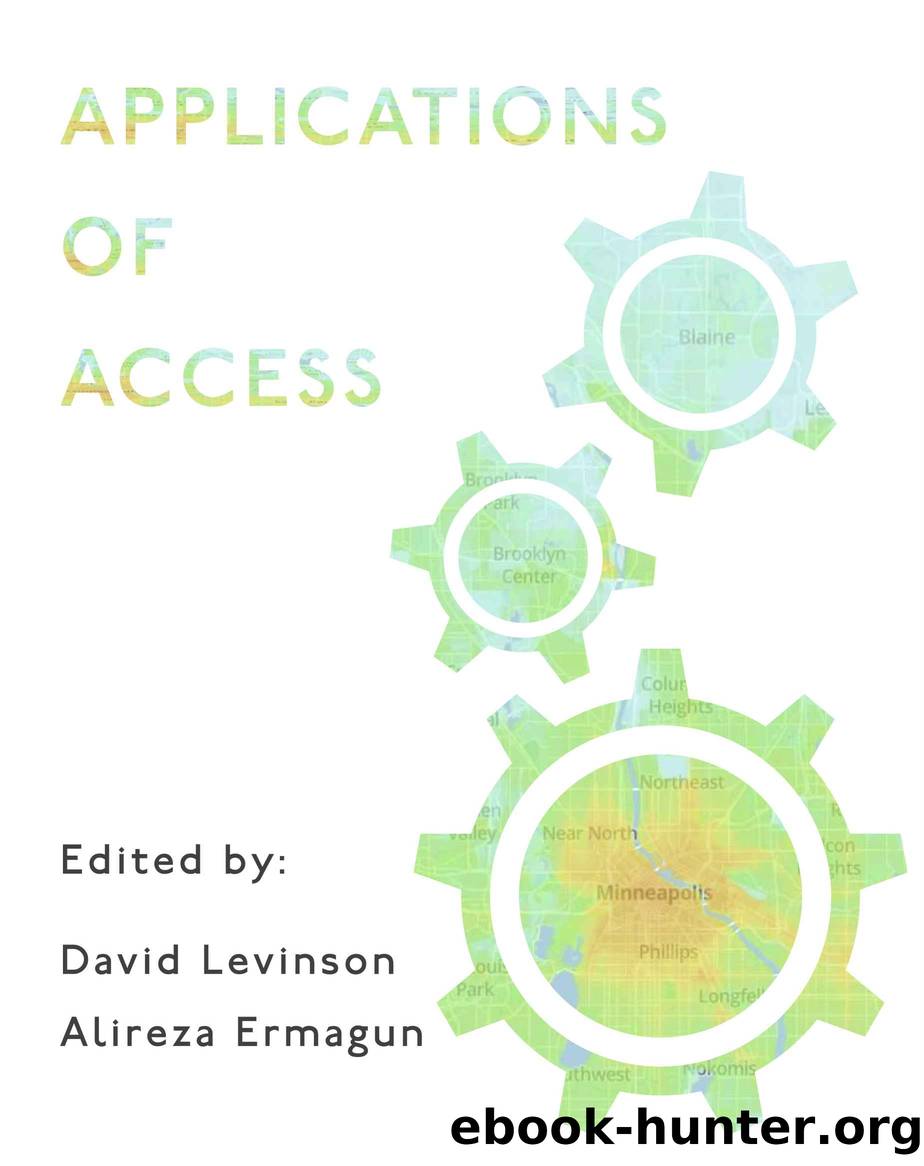Applications of Access by Levinson David & Ermagun Alireza

Author:Levinson, David & Ermagun, Alireza [Levinson, David]
Language: eng
Format: epub
Publisher: Network Design Lab
Published: 2021-12-06T16:00:00+00:00
Findings
Identifying random effectsTo examine whether there exist extra random effects, we plot the residuals versus fitted values histogram of the residuals for fixed-effects linear model (Figure 12 .4 ). Figure 12 .4 shows that residuals do not symmetrically center around 0 . There seems minor evidence of the histogram of the residuals being skewed to the right. The problem may be partially due to repeated observations for each individual over the sampling period. To simply observe that effect, we run separate models for each individual, where the independent variable is day of week and the dependent variable is the ln form of the number of daily trips. The 95 percent confidence intervals for the intercepts and slopes are shown in Figure 12 .5 . There exist substantial variations in the intercepts among individuals, and there are also apparent individual-to-individual variations in the slopes. It signals the existence of extra random effects in the data. Therefore, mixed-effects models are considered as more appropriate than traditional fixed-effects models. to verify homogeneity and a
normality based on the regular
Testing the number of categoriesIn our data, the number of trips ranges from 0 to 17 (16 is missing). Therefore for the mixed-effects ordered logit model, we can test different numbers of categories ranging from 2 to 17 with an increment of 1 . The goodness of fit (measured by Nagelkerke R2 ) of the mixed-effects ordered logit models with different numbers of categories of trips is shown in Table 12 .4 . The results indicate that the models produce similar Nagelkerke R2 values and similar estimates of the coefficients. Models with categories from 7 to 16 have approximately the same Nagelkerke R2 value which is slightly higher than the models with fewer categories. In addition, the number of days with more than 5 trips account for less than 3% of all days. It seems reasonable to select 7 categories (0, 1, 2, ..., 5, >5) by combining more than 6 daily trips as one category.
Comparing Poisson and negative binomial Regarding the choice of the Poisson and negative binomialstructures, if the mean of the dependent variable equals the variance, then the Poisson model is preferred. But if the variance is greater than the mean, negative binomial would be a better fit. We compare the goodness of fit of the Poisson model and negative binomial model for our data. The test used is the likelihood-ratio Chi-squared test where the null hypothesis is that the dispersion
16 ( Cameron and Trivedi 1998 ). parameter equals 0 .16 We run the mixed-effects negative binomial model and obtain its log likelihood value (LLnb = â8361.32). Then the mixed-effects Poisson model is examined and its log likelihood value is also recorded (LLp = â8567.505). The next step is to calculate Ï 2 = â2(LLp â LLnb ) = 33.72. Its p-value is smaller than 0 .01 for df = 1 . The large test statistic suggests that the count data are over-dispersed and cannot be sufficiently described by the Poisson distribution. Therefore the mixed-effects negative binomial model is deemed as a better fit.
Download
This site does not store any files on its server. We only index and link to content provided by other sites. Please contact the content providers to delete copyright contents if any and email us, we'll remove relevant links or contents immediately.
Kathy Andrews Collection by Kathy Andrews(11676)
The remains of the day by Kazuo Ishiguro(8738)
Paper Towns by Green John(5022)
Spare by Prince Harry The Duke of Sussex(4993)
The Body: A Guide for Occupants by Bill Bryson(4884)
Industrial Automation from Scratch: A hands-on guide to using sensors, actuators, PLCs, HMIs, and SCADA to automate industrial processes by Olushola Akande(4841)
Machine Learning at Scale with H2O by Gregory Keys | David Whiting(3964)
Be in a Treehouse by Pete Nelson(3875)
Harry Potter and the Goblet Of Fire by J.K. Rowling(3736)
Never by Ken Follett(3701)
Goodbye Paradise(3665)
Into Thin Air by Jon Krakauer(3261)
The Remains of the Day by Kazuo Ishiguro(3253)
The Cellar by Natasha Preston(3218)
The Genius of Japanese Carpentry by Azby Brown(3188)
Fairy Tale by Stephen King(3155)
120 Days of Sodom by Marquis de Sade(3116)
Drawing Shortcuts: Developing Quick Drawing Skills Using Today's Technology by Leggitt Jim(2960)
The Man Who Died Twice by Richard Osman(2953)
